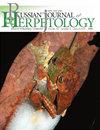The «Empty Forest Syndrome» and the Herpetofaunal Communities in Laos (South-Eastern Asia)
IF 0.9
4区 生物学
Q3 ZOOLOGY
引用次数: 4
Abstract
Nowadays, Laos remains one of the scientifically least known countries of Asia in terms of herpetological knowledge. Here, we evaluate composition of species in freshwater ecosystems (main river courses) and terrestrial ecosystems (forests) in two distinct regions using Visual Encounter Surveys along designed transects, examination of fishers’ catches and standardized interviews. In Northern Laos, we recorded only 18 reptile individuals (2 turtle and 1 snake species). Interview surveys demonstrated that in Nam Xam River, fishers are more likely to hunt turtles and we identified one potential site where the world’s rarest turtle, Rafetus swinhoei, could be still present in the wild. In Nam Et Phou Louey National Park, we found 19 reptile species (8 lizard, 10 snake, 1 turtle species) in the different study sites, demonstrating a low species density in all different surveyed habitats. In Central/Southern Laos, we observed 30 species of reptiles (14 snake, 16 lizard, 35 amphibian species). Our study offers preliminary insights into the composition of amphibians and reptiles in Laos. The great majority of the species were non-threatened or not evaluated, and a few were threatened, suggesting that more research is needed to proper understand the conservation status of Laos’ herpetofauna. We highlighted, indirectly by interviews with local fishers, the possible presence of the turtle Rafetus swinhoei, thus providing a new hope for avoiding the extinction of this species. Finally, we observed a relatively low number of species in each habitat type, which is remarkably lower than in tropical forests of other continents or of nearby south-east Asian countries, indicating that the herpetofauna communities in Laos are depleted, reflecting an ‘empty forest syndrome’.老挝(东南亚)的“空林综合症”与疱疹动物群落
如今,老挝仍然是亚洲最不为人所知的爬虫学国家之一。在这里,我们评估了两个不同区域的淡水生态系统(主要河道)和陆地生态系统(森林)的物种组成,方法是沿着设计的样带进行视觉接触调查,检查渔民的捕捞量和标准化访谈。在老挝北部,我们只记录到18只爬行动物个体(2只乌龟和1只蛇)。访谈调查表明,在南萨姆河,渔民更有可能捕猎海龟,我们确定了一个潜在的地点,那里可能仍然存在着世界上最稀有的龟,Rafetus swinhoei。在Nam Et Phou Louey国家公园,我们在不同的研究地点发现了19种爬行动物(8种蜥蜴,10种蛇,1种乌龟),表明在不同的调查生境中物种密度都很低。在老挝中南部共发现爬行动物30种(蛇14种,蜥蜴16种,两栖动物35种)。我们的研究为老挝两栖动物和爬行动物的组成提供了初步的见解。绝大多数物种未受到威胁或未被评估,少数物种受到威胁,这表明需要更多的研究来正确了解老挝的爬行动物区系的保护状况。我们通过与当地渔民的访谈间接强调了可能存在的龟,从而为避免该物种的灭绝提供了新的希望。最后,我们观察到每种栖息地类型的物种数量相对较低,明显低于其他大陆或邻近东南亚国家的热带森林,这表明老挝的爬行动物群落已经枯竭,反映了“空林综合症”。
本文章由计算机程序翻译,如有差异,请以英文原文为准。
求助全文
约1分钟内获得全文
求助全文
来源期刊

Russian Journal of Herpetology
ZOOLOGY-
CiteScore
1.70
自引率
0.00%
发文量
29
期刊介绍:
Russian Journal of Herpetology is an international multi-disciplinary journal devoted to herpetology. Russian Journal of Herpetology accepts original papers on ecology, behavior, conservation, systematics, evolutionary morphology, paleontology, physiology, cytology and genetics of amphibians and reptiles.
Types of Contributions:
-original papers
-invited or contributed reviews on specific topics
-short communications on topics of immediate interest, new methods and ideas in progress
-notices of meetings, symposia, and short courses
-book reviews
 求助内容:
求助内容: 应助结果提醒方式:
应助结果提醒方式:


